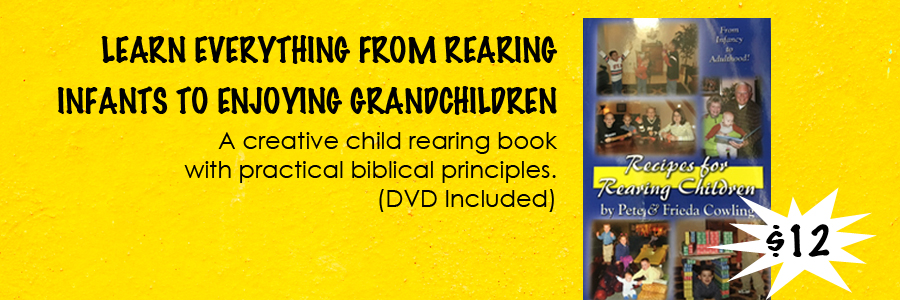by Pam Hibbard
Hammond, IN
Each student should be seen as an unbuilt relationship, waiting for one teacher to reach out to the heart of that student. Our students need to feel the deep, very real love that comes from the meaning of the word “Mom.” A mom will love her children 52 weeks of the year with a genuine, unending love. As a teacher, we have the wonderful opportunity to deeply love our students, realizing that each student is so very different. Our students long for a teacher who will love them as a mom loves her children.
Jesus was a builder of people. As Jesus daily walked among people, lives were changed. We can learn from our Saviour to be builders of students. God mentioned the word “build” a total of 162 times in the Bible. As a construction worker strives to put his best into his buildings, we, as teachers, must daily construct lives and build relationships.

“Is Your Fruit Sweet or Sour? A Teen Girl’s Guide to Christian Living” by Karen Finn (Click on the image for more information.)
The following 52 ideas are ways that I try to build relationships with each of my students.
- Teach with feeling and impart that feeling to your students.
- While teaching your subject, drill into each lesson the importance of life.
- Create daily lessons into unforgettable adventures. How often have we been captivated by the teacher who seized our attention and imagination.
- Express a positive belief in the individual life of each student. We will strive to please the person who believes in us. So many of our students have little sense of the fact that God created them for a very special reason.
- Listen to the words of your students. They have so much to tell you. The more that I can listen to a student, the more I will know that student as an individual. This gives me direction in future teaching. This is not correction time; this is listening time.
- While keeping a planned distance, become a teacher whom students can know. We have a reverence for our mom; yet, she is a person with whom we can easily talk. As much as we want to know our students, they want to know us.
- Be willing to share extra time with your students. Let students know that the door of your room is open in the mornings. When possible, eat lunch with your students instead of with other teachers. Invite students to go soul winning with you. Make a point to talk with different students during each break. Talk with students as they are loading their buses. Walk a student to the car of a waiting parent. Walk slowly among the students.
- Allow students to enjoy your laughing with them. Laughter heals troubled hearts.
- Express love and praise into everyday conversations. As I pass my City Baptist students now in college, I still say “I love you” before I leave them. To the young men, I still say “You are important to me,” or some other similar statement.
- Build friendships as you walk among the students. Reach out to them before they have a chance to be a friend to you.
- Remember that, as a teacher, you exist for the purpose of building those students.
- Pray for and with each student. Give notes assuring your students that you are praying for them. Some of those notes will last a lifetime.
- Collect, and display proudly, pictures of your students. I keep a small camera in my room to capture class memories. These can be displayed on chalkboards or bulletin boards.
- Make unexpected, encouraging phone calls to build individuals. Never forget how you feel when someone in leadership expresses some kindness to you. This is the way that we make our students feel.
- Visit each home and sit where your students sit. Keep these visits positive.
- Mail letters and post cards to your students. Young people love to get mail.
- Delight in the smallest gift from a student. If at all possible, display these gifts somewhere in your room.
- Be a full-time teacher, not a teacher just “putting in time.” Time is a builder of relationships.
- When needed, be reachable beyond the classroom. Only Heaven will reveal the lives that have been salvaged because a teacher was available at a needed moment.
- Involve yourself in helping students overcome personal battles. We are missionaries in our classrooms. Whatever the situation, we must remember that our students need us.
- Become a “boost giver” to a student who seems discouraged or fearful.
- If possible, help to meet the material needs of your students. Jesus has often been fed lunch or clothed by the kindness of a teacher to a student. Ask yourself these kinds of questions:
- Why is a student not eating lunch?
- Does a student wear the same clothing day after day because he wishes to do so?
- Though he says he forgot, does a student need school supplies?
- Does a student wear a lightweight jacket because he has no winter coat?
- His glasses are broken, and he says that Mom is going to take care of them. Can I help?
- Be willing to deal with the “unlovely” circumstances to produce a “king” or a “queen.” Royalty sits in front of us each day.
- Use illustrations and stories that capture the attention and interests of individual students.
- Don’t be afraid to cry with your students. Your compassion will stay with them in difficult times.
- Learn the smallest details about your students. A student may like butterflies. I will put butterflies on that day’s math test. A student finds his favorite candy bar taped to his locker.
- Encourage and build a relationship with the family members of each student. We want others to love those whom we love.
- NEVER gossip to another teacher about your students. Do not destroy the great trust that a student has placed in you.
- Write thank-you notes to your students for their acts of kindness. Write notes expressing good character qualities. This will help to create an “others-oriented” student.
- Students are starving for good discipline. Providing that kind of discipline will build a respect between you and the student which will in turn draw them closer to you.
- Build other faculty and staff members to your students. The more they love other leaders, the more they will reciprocate that love. We do not know which person in the life of a youth will become the difference maker.
- Within the classroom, allow students to help you. You are helping them as they are helping you.
- Never be afraid to say to a student that you made a mistake or when needed, that you are sorry.
- Be willing to start individually where each student needs you to begin. This past year, I taught a senior girl phonic sounds. That was the place where she needed me to start.
- Sit in the desk of every student and ask God for wisdom and love for the student who will sit there the next day.
- Share good books with individual students.
- As much as possible, call the names of your students in front of others.
- With very wise discretion, find little ways to show affection.
- Establish and display expectations for each student. Help the individual to reach new heights.
- Ask the advice of your students. This is a strong tool in building relationships. We want to think that someone feels our thoughts are important.
- When possible, walk beside your students. I love to go on activities where I can walk beside my students. Sometimes we talk the entire way. Sometimes we just listen to the quiet thoughts of each other.
- Without embarrassing a student, be willing to help in areas of personal hygiene and dress. If we are not careful, we assume that the simple is known.
- Use every opportunity to enjoy activities with your students. Swallow your pride and join in the fun. Allow your students to enjoy the “youth” in you.
- Sing with your students. Truths can be taught in good music.
- After school hours or at lunch, play games with your students. One of my junior English students took great pride in teaching me to play chess. I enjoyed it for his sake. Keep a puzzle not finished. A student will love to help you find the missing pieces.
- After the year has ended and the door has been shut, continue to build those relationships. During the summer or upon graduation is a time when much attention is still needed. A mother’s love doesn’t stop when the children leave home.
- Decorate your classroom with your students in mind. We love to go into a room that is beautifully decorated, smells good, and feels comfortable. Our students deserve a warm learning environment.
- Allow each student to feel your joy of teaching. You may be influencing the future teacher who will make a difference in the lives of others.
- Write individual and personal comments on student’s papers. They can be serious or funny.
- Enjoy nature with your students. In English last year, we stopped to watch a squirrel throw food from a bird feeder to the birds on the ground. Students gathered close as I was the first one to the window.
- Create a desire to learn new things by placing your hand upon their hand. That touch means, “I care.” At times having one person care will spur a student on to new accomplishments.
- Even in the times when your heart is breaking, never give up on a student. Time can change that which is presently wrong.
When I heard a motherless student say, “I wish you were my mom,” I tingled inside. I have just begun to become the teacher God wants me to be. As a teacher, I can feel the educational heartbeat of a mom.








This is a wonderful thought provoking article. I loved reading it and I will apply it to my grandchildren as well as my grown children. Also with others I come in contact with.